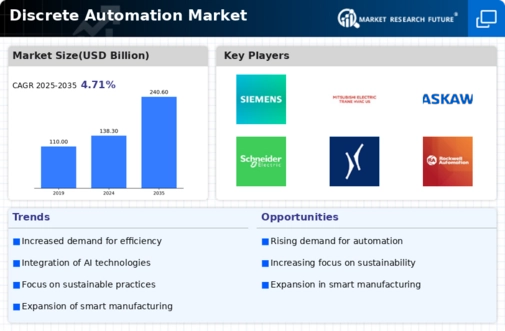Rising Labor Costs
Increasing labor costs across the globe are driving the Global Discrete Automation Market Industry towards automation solutions. Companies are compelled to invest in automated systems to maintain competitiveness and profitability. For example, in regions with high labor costs, such as North America and Western Europe, businesses are increasingly adopting automation technologies to offset these expenses. This trend is expected to contribute to the market's growth, with projections indicating a value of 240.6 USD Billion by 2035. The shift towards automation not only addresses labor cost challenges but also enhances production efficiency.
Global Economic Growth
The Global Discrete Automation Market Industry is poised to benefit from overall global economic growth, which fosters increased industrial production and investment in automation technologies. As economies expand, businesses are more inclined to invest in advanced manufacturing solutions to enhance productivity and efficiency. The anticipated compound annual growth rate of 5.17% from 2025 to 2035 reflects this trend, as industries recognize the need for automation to remain competitive in a rapidly evolving market landscape. Economic growth thus serves as a catalyst for the adoption of discrete automation solutions across various sectors.
Demand for Customization
The Global Discrete Automation Market Industry is witnessing a growing demand for customized solutions tailored to specific industry needs. As consumer preferences evolve, manufacturers are compelled to adapt their production processes to offer personalized products. Automation technologies facilitate this flexibility, enabling rapid changes in production lines without significant downtime. This trend is particularly evident in sectors such as automotive and electronics, where customization is paramount. The ability to quickly adjust to market demands positions automation as a critical component in maintaining competitive advantage, further propelling market growth.
Market Growth Projections
The Global Discrete Automation Market Industry is projected to experience substantial growth, with forecasts indicating a market value of 138.3 USD Billion in 2024 and 240.6 USD Billion by 2035. This growth trajectory suggests a compound annual growth rate of 5.17% from 2025 to 2035, highlighting the increasing adoption of automation technologies across diverse industries. Factors such as technological advancements, rising labor costs, and sustainability initiatives are likely to drive this expansion. The market's evolution reflects a broader trend towards digitization and efficiency in manufacturing processes, positioning automation as a cornerstone of future industrial strategies.
Sustainability Initiatives
Sustainability initiatives are increasingly influencing the Global Discrete Automation Market Industry as companies strive to reduce their environmental impact. Automation technologies contribute to energy efficiency and waste reduction, aligning with global sustainability goals. For instance, automated systems can optimize resource usage, leading to lower energy consumption and minimized waste generation. As regulatory pressures and consumer expectations regarding sustainability rise, businesses are more likely to invest in automation solutions that support these objectives. This shift not only enhances corporate responsibility but also drives market growth as organizations seek to implement greener practices.
Technological Advancements
The Global Discrete Automation Market Industry is experiencing a surge in technological advancements, particularly in robotics and artificial intelligence. These innovations enhance operational efficiency and reduce production costs, making automation more accessible to various sectors. For instance, the integration of AI in manufacturing processes allows for predictive maintenance, minimizing downtime and increasing productivity. As industries adopt these technologies, the market is projected to reach 138.3 USD Billion in 2024, indicating a robust demand for automated solutions that streamline operations and improve overall performance.





















Leave a Comment